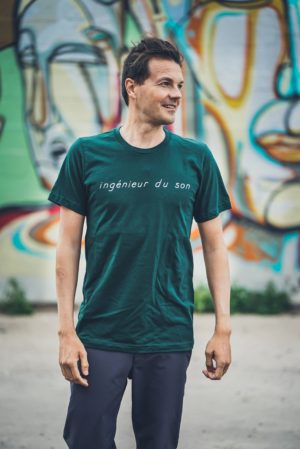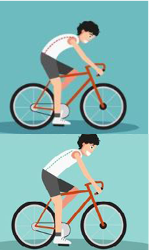As cyclists, we want to be economical and good cycling posture plays a significant role in doing this. Because of the countless hours we end up sitting on our bikes, it would be wise to figure out how best we can achieve efficiency in order to avoid damage to our bodies and improve overall cycling performance.
The question here is: How can we improve cycling posture?
To become better at something, you need to become more efficient. The truth(s) we are actually seeking is how do we get better on the bike? How do we avoid overuse injuries? And how do we get more for less while cycling?
torwaiphoto/Adobe Stock
A great question can sometimes be answered with an equation – and one for efficiency already exists. Borrowed from physics, it reads as follows
Efficiency = Output/Input
In cycling terms: Greater output (cycling performance) divided by lesser input (work done on the bike & wind resistance) will equal more efficient cycling.
One way to lessen the input is by improving posture.
Cycling Posture
After you’ve had a professional bike fit done to reduce hot spots and accommodate your unique proportions, the next thing to address will be your posture. The reason is because using the wrong postures at the wrong times (or just doing them poorly) while riding can make you a far less efficient cyclist…
Increased wind resistance, bleeding force, overloaded joints and overworked muscles are just some of the damage we do to ourselves and our biking when posture gets compromised. You end up putting in more work (higher input) for less reward (lower output), opposite of the desired variables in our formula above.
Today we want to give you 5 tips to improve your cycling posture so you not only feel better on the bike, but also increase your longevity, lower your injury risk, breathe better and enjoy yourself more – even on tough rides.
#1. Adjust Your Hand Position
There are three hand positions that you’re going to use throughout your ride, and it’s important you use the right one at the right time. They each have significant influence over how the rest of your body will be positioned, all with their own advantages, disadvantages and specific use:

Tops
You should be using your tops when you’re at the front of the group, riding alone or climbing a hill. This allows you to be in a more upright position where you can take in deeper breaths, have a better view of the road, pedal hard and be overall more comfortable on the bike.
Hoods
This is where you’ll be the majority of the time, think of it as a maintenance position for when you’re cruising on flat terrain and maintaining a steady cadence. This is a good position to relax into and conserve energy with easy access to your shifters or brakes should you need them.
Drops
Your most aggressive position and ideal for descending down hills as it lowers your center of gravity. You’ll naturally be able to shift your weight back and literally “drop” into a more aerodynamic position; increased output (speed/distance) and lowered input (pedaling/wind).
#2. Remember To Breathe
Not getting enough oxygen in is going to force your body to compensate through your posture. You’ll start to crane your neck, your breathing will get erratic and exaggerated, your lower back will arch, and basically everything will fall apart. Breathing is not something you can mess with on a human being without some sort of consequence.
There’s a couple of ways to address this, number one is to improve your strength and conditioning so that the stimulus of cycling isn’t so stressful on your body. The better shape you’re in, the more calm you’ll be on the bike. You can learn to modulate when your body breathes deeply for recovery and when it should really push for a sprint or hill climb.
Number two, maintain good posture even when you’re at the limits of your fitness. “Fake it until you make it”, in a sense. The reason is because you want to send the signal to your brain that you’re in control. Try your best to harmonize yourself with the stress, and you’ll recover faster when you hit flat ground or return to a more steady pedal rate. Keep it together!
#3. Engage Your Core
Maintaining some degree of stiffness in your core is going to help support your back (keeping it from collapsing) and give your legs something solid to push off of. The lower extremity is connected to your torso through the hip flexors, and pushes/pulls on the pedals in concert with the contraction of your core muscles in the front and back of your body.
Especially as you drop into a more folded position, it’s important to keep your tail slightly tucked (pelvis rotated back) to keep your core engaged. This will increase the power output from your legs, and also disperse the load more evenly throughout your body.
Remember that any break in the kinetic chain (combined muscle activity to perform a movement) will cause force to bleed out and be wasted. For many people, this is the core, and it presents itself as an arched lower back on the bike or abnormal movement patterns that don’t look or feel natural.
#4. Relax Your Body
Too much tension on the other hand, is also going to affect the way you look and move on the bike. While the goal is to produce force, pedal hard and cycle fast while riding, we also need to be able to adapt, stay loose and complete the distance we’re setting out to do.
Put that chattering voice in your head to work by giving yourself reminders throughout the ride. Relax the shoulders and bring them down from the ears. Soften the elbows so they can act as your built-in natural shock absorbers. Unclench the jaw and relax your face. Loosen the grip and use only as much muscle as you need.
Bodybuilders know the effects of this all too well – they commonly report extreme muscle soreness and fatigue after doing a posing routine on stage. All their energy goes into those poses, but it doesn’t need to go into ours. Learn to catch yourself wasting unnecessary energy and gain it back through small reminders to relax.
Pattadis/Adobe Stock
#5. Control Your Exertion
Bursting too hard out of the blocks is a common problem among many types of athletes. In our sport, it can have some seriously negative effects on your cycling posture. If you overexert yourself too soon and use up all your reserves, you might not have the capacity to recover, and form will just slowly break down further and further as the ride goes on.
A proper warm up can really help mitigate this problem. It gives you the time to get yourself in a good headspace, go through the race or training plan in your mind, and figure out how best to approach the peaks and valleys of this session.
If you can stay relaxed in the right places, you’ll be able to fine tune the juxtaposition between your periods of recovery and moments of intense exertion (sprint, hill climb, attack, finish). This helps maintain overall composure, resulting in better race outcomes and training results over time.
Ride Pain & Injury Free For LIFE
If you’re looking for an all-inclusive training platform available to you 24/7 for a low monthly cost – check out, Dynamic Cyclist. They offer daily stretching and strength training video routines designed specifically for cyclists. Created by industry professionals, these programs will take your cycling to the next level and help you reach your full potential. So, whether you’re a beginner or an experienced rider, Dynamic Cyclist has everything you need to improve your performance and keep riding for years to come. Experience the results for yourself. You can try it for FREE by signing up HERE!.



